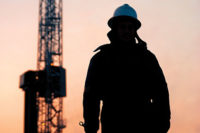Please tell me, is there any way to get out of here? We are going totally mad.”
That’s a construction worker from Nepal, interviewed by Amnesty International, who is working in Qatar, where a building boom is taking place in advance of the 2022 World Cup of soccer. The worker has been unpaid for seven months, and prevented from leaving Qatar for three months. On one construction project, Nepalese workers said they were “treated like cattle.” Employees worked up to 12 hour days, seven days a week, including during Qatar’s brutally hot summer months.
A firestorm of international media coverage has focused on alleged labor abuses in Qatar in connection with the run-up construction blitz to the 2022 World Cup. Qatari government officials vehemently deny estimates that more than 4,000 employees will die building the World Cup infrastructure, and that 1,200 workers have died in Qatar since it was awarded the World Cup in 2010. “After almost five million work-hours on World Cup construction sites, not a single worker’s life has been lost,” said the government.
It’s a small world
What has ensued in recent months is a familiar debate about the accuracy of job safety statistics. That’s not the subject of this article. One of the subplots to this international controversy is the reported high number of worker deaths due to sudden cardiac arrest and heat attacks. And here there is gist for many U.S. safety and health professionals to review possible connections between work conditions, stress factors, and sudden deaths due to cardiac arrest.
There are 220,000 victims of sudden cardiac arrest per year in the U.S., and about 10,000 of them occur at work, according to OSHA. Construction work is not one of the high-risk occupations for death due to cardiovascular disease. Emergency responders are a particular high-risk population: almost half of all firefighter deaths are due to cardiovascular disease, according to the United States Fire Administration.
“High demand, little control”
So-called “high demand, little control jobs” increase the risk of cardiovascular-related fatalities. These are jobs – white collar and blue collar – where employees have little or no control over the pace of work or other aspects of their job. “Being out of control of your own fate is an increased stressor leading to cardiovascular disease,” said a British researcher. A study of about 11,000 British civil servants found men and women with low job control had double the risk of heart disease as those with more control over their work. Another finding: a 67 percent increased risk for coronary heart disease existed among British civil servants who worked 11 or more hours a day compared to those only working 7 to 8 hours. “There’s a relationship between workload and coronary artery disease,” said another researcher.
There’s nothing new about the association between job stress and illness – it was recognized 300 years ago by the pioneering occupational physician Bernardo Ramazzini. More recently, studies of nearly 200,000 employees from seven European countries found workers with highly demanding jobs and little control over decision-making were 23 percent more likely to have a heart attack during the 7.5-year study, compared to peers with less job stress.
Many faces of stress
Of course job stress has many faces. Job insecurity is a common cause of stress. So, too, being mistreated emotionally or physically on the job, tension in the work environment, heavy workloads, infrequent rest breaks, long work hours, shift work, lack of support or help from coworkers and supervisors, poor communication, lack of participation by workers in decision-making, lack of opportunity for advancement or promotion, and lack of company policies that take employees’ families and personal obligations into account.
Seen in this light, work conditions in Qatar relating to the oil-fueled $148-billion building boom -- which was actually started by surging economic growth in 2006 to 2009 and extends beyond construction of nine new World Cup stadiums to include highways, an airport, bridges, tunnels, 20 skyscrapers in the capital of Doha, a sewage system for the city, and an entire new city – represent a perfect storm of job stresses. Qatar is a tiny Middle East peninsula, barren and sandy, about the size of Connecticut, with a population of about 2.2 million, comparable to New Mexico, and the richest country in the world based on GDP per capita. About 85 percent of Qatar’s population consists for migrant workers from Nepal, India, Bangladesh, Pakistan, Egypt, the Philippines and other countries.
Recipe for disaster
This is the Qatari recipe for job stress which could contribute to the unexplained number of sudden deaths, often at night while sleeping, linked to heart failure: 1) a worker decides to leave his family and country in hopes of finding income to support his family; 2) the worker takes out a high-interest loan and pays an exploitative recruiter for a job in Qatar; 3) Under Qatar’s kafala system, many migrant workers are tied to their employers for the length of their contract and lack freedom to change jobs, leave the country, find a better job, or return home; 4) many migrant workers are employed by small or mid-sized contractors who ignore safety and health measures and can withhold pay for weeks or months, if they pay at all; 5) construction workers can put in 10-12 hour days without breaks or hydration in temperatures that average 107 degrees in June, July and August (the World Cup competition has been moved to December); 6) many migrants live in dorms or camps, sometimes sleeping 12-18 to a room, on the floor, with rodents, dilapidated cooking and plumbing and bad food; and 7) the worker, often the head of a family, is away for years with virtually no contact, and his family back home sees little to no financial benefits.
After intense international media coverage of the plight of migrant workers in Qatar, the government commissioned an investigation by the international law firm DLA Piper. The firm’s report recommended that Qatar do more to record and investigate “unusual trends in in causes of deaths, such as high instances of cardiac arrest.”
Taking the heat off
That recommendation has so far gone unheeded, although Qatar has upped the number of government safety inspectors from eight in 2006 to 80 today to 300 by year’s end; increased minimum accommodation space per worker by 50 percent; mandated the presence of a full-time nurse in every site that houses 100 or more workers; and cracked down on safety and health enforcement. This past July, Qatar shut 42 construction sites found to have violated the midday break law, which bans outdoor work from 11:30 am to 3 pm, from June 15 to August 31. The move follows 475 surprise raids on work sites across the country.
In a statement, the Qatar Ministry of Labour said, “While the vast majority of workers in Qatar are fairly treated, we recognize that a minority are not. We understand we have much more to do, we have much to learn and we are determined to be a model for labour reform in the region.”




